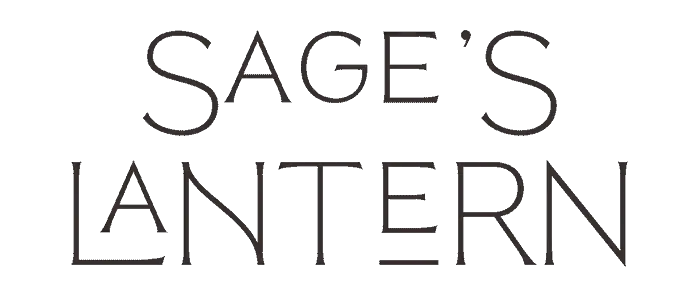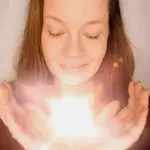Are you confused about the difference between the major and minor arcana? Fear not! Even if it sounds complicated and mysterious, they only refer to different human experiences and happenings. When you have cracked the code, it will be as second nature.
The Major Arcana cards represent big, overarching themes and spiritual lessons. The Minor Arcana cards represent our lives in more practical and day-to-day aspects.
In this article, we’ll break it down for you in a fun and easy-to-understand way. Get ready to discover the distinctive qualities of these two tarot categories and how they can help you enhance your readings. So, let’s dive in!
The difference between the Major and Minor Arcana
If you are not into the nitty-gritty of the Arcanas (life secrets), here is the short version for you! The Major Arcana is all about life-changing events that alter the course of your life path (often sounds scarier than it is). The Minor Arcana is all about everyday happenings and situations.
- Major Arcana – Life-changing happenings and life lessons
- Minor Arcana – Everyday experiences and situations.
The Tarot deck is divided into two main sections: the Major Arcana and the Minor Arcana. The Major Arcana comprises 22 cards, while the Minor Arcana comprises 56 cards.
If you want to learn in-depth what the Major and Minor Arcana represent, I invite you to explore the articles below.
Further reading: Soul’s Journey: Meaning of Major Arcana Cards
Further reading: Beyond the Major: Profound Influence of the Minor Arcana
The Major Arcana
The Tarot deck is divided into two main sections: the Major Arcana and the Minor Arcana. The Major Arcana comprises 22 cards, while the Minor Arcana comprises 56 cards.
The picture below is an example of cards from the Major Arcana.
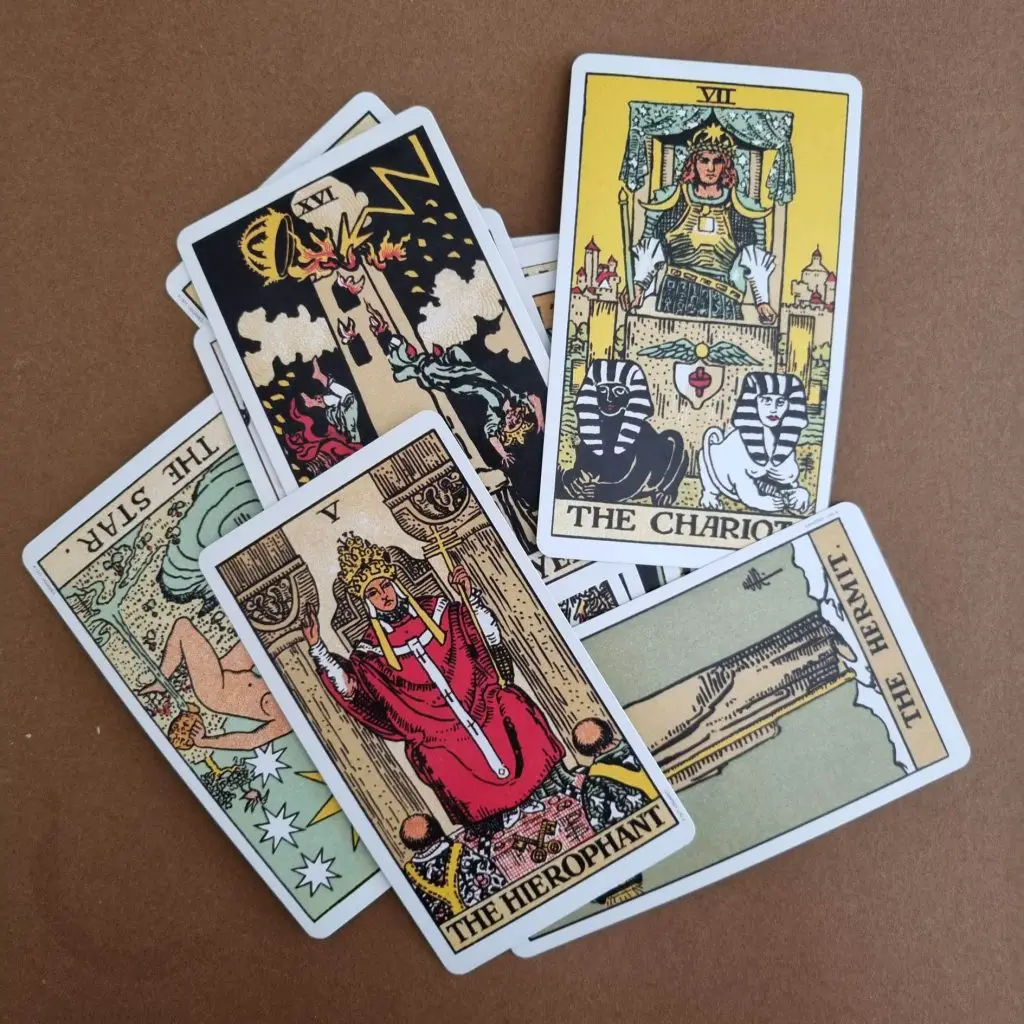
The Major Arcana cards are called the “trump cards,” representing major life events, archetypes, and spiritual lessons. They have names on them, for example, The Emperor, Death, The Hanged Man, The Fool, and so forth.
Each Major Arcana card is numbered and has a distinct meaning that can be interpreted in various ways.
The Major Arcana cards are typically associated with deep introspection and personal growth. They can indicate life-chancing happenings and situations. They guide important life decisions and are often considered the backbone of the tarot deck.
In most cases, you use the Major and Minor Arcana together. You can read tarot with only the Major Arcana cards in certain circumstances.
To learn more about this, read the article below.
Related article: Tarot Readings With Major Arcana Cards: Pros And Cons
The Minor Arcana
The Minor Arcana cards are divided into four suits (Wands, Cups, Swords, and Pentacles), each with 14 cards.
The suits correspond to different aspects of life, such as creativity, emotions, intellect, and material possessions.
Each suit has a numbered series from Ace to 10 and four court cards (Page, Knight, Queen, King).
The Minor Arcana cards are typically associated with the everyday events and experiences of our lives and offer guidance on practical matters such as relationships, careers, and finances.
Identify major arcana cards
Now you know what the different Arcanas mean, but how do you identify them? The cards might look different depending on what kind of tarot deck you use.
The Major Arcana cards are the deck’s 22 most influential and significant cards. These cards represent major life events, lessons, and themes.
To make this easier, I will show you how the Original Rider-Waite deck looks. This is the “standard tarot deck” and the one most used; if you want to get this tarot deck, you find it on my recommended products page.
Let’s talk about how to identify these cards. Each major arcana card has a distinct image and symbolism to help you recognize it. You will find the card’s name at the bottom of the card and a Roman number at the top.
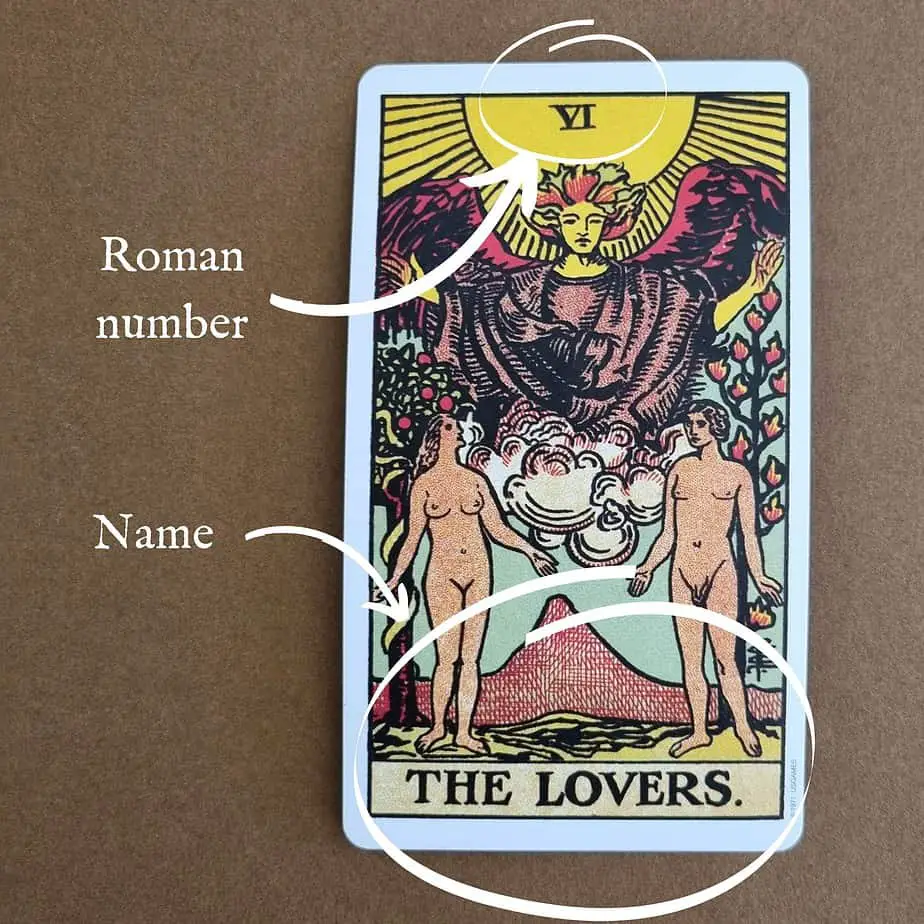
For example, The Fool is often depicted as a carefree person on a journey with a dog by their side. The Magician is shown holding a wand and surrounded by tools, representing the power of manifestation. The High Priestess is usually depicted with a book, describing intuition and hidden knowledge.
When you can identify them, you might also want to know what they mean. By learning the cards’ meanings, you will gain a deeper understanding of the differences between the Arcanas.
In the table below, you will find a cheat sheet for the Major Arcana cards. As you notice, the meanings are more energetic than a “happening” or “situation.”
Major Arcana card’s name and meanings
| Card Number | Card Name | Card Meaning |
|---|---|---|
| 0 | The Fool | Beginnings, spontaneity, innocence, freedom, new opportunities |
| 1 | The Magician | Manifestation, creativity, power, action, resourcefulness |
| 2 | The High Priestess | Intuition, wisdom, secrets, mystery, hidden knowledge |
| 3 | The Empress | Nurturing, abundance, fertility, creativity, sensuality |
| 4 | The Emperor | Authority, structure, power, stability, leadership |
| 5 | The Hierophant | Tradition, spirituality, religion, teaching, guidance |
| 6 | The Lovers | Love, relationships, choices, harmony, attraction |
| 7 | The Chariot | Control, determination, willpower, success, achievement |
| 8 | Strength | Inner strength, courage, endurance, self-control, fortitude |
| 9 | The Hermit | Solitude, introspection, wisdom, inner guidance, search for truth |
| 10 | The Wheel of Fortune | Change, cycles, destiny, karma, unexpected events |
| 11 | Justice | Balance, fairness, truth, cause and effect, legal matters |
| 12 | The Hanged Man | Surrender, letting go, sacrifice, patience, new perspectives |
| 13 | Death | Endings, transformation, change, rebirth, letting go |
| 14 | Temperance | Balance, moderation, harmony, integration, self-control |
| 15 | The Devil | Materialism, temptation, addiction, bondage, unhealthy relationships |
| 16 | The Tower | Upheaval, chaos, change, revelation, sudden realization |
| 17 | The Star | Hope, inspiration, renewal, intuition, guidance |
| 18 | The Moon | Illusion, intuition, the subconscious, mystery, the unknown |
| 19 | The Sun | Joy, success, vitality, positivity, happiness |
| 20 | Judgment | Rebirth, awakening, renewal, second chances, spiritual growth |
| 21 | The World | Completion, fulfillment, unity, achievement, wholeness |
As you familiarize yourself with the tarot deck, you’ll recognize these images and symbols more easily. You can also use tarot resources, such as books or the tarot cheat sheet, to learn more about each card’s meaning and symbolism.
Remember, tarot is a highly personal practice; everyone may interpret the cards differently. Trust your intuition, and don’t be afraid to explore and experiment with different interpretations of the cards.
Identity Minor Arcana cards
Unlike the Major Arcana, the Minor Arcana consists of 56 cards divided into four suits: wands, cups, swords, and pentacles.
Each suit represents a different element and aspect of life. The suits are also associated with different personality traits and characteristics.
Here’s a quick breakdown of the suits and their meanings:
- Wands: Represent the element of fire and are associated with action, creativity, and ambition. They can also indicate challenges or conflicts.
- Cups: Represent the element of water and are associated with emotions, relationships, and intuition. They can also indicate opportunities for love and growth.
- Swords: Represent the element of air and are associated with thoughts, communication, and mental clarity. They can also indicate challenges or conflicts related to communication or decision-making.
- Pentacles: Represent the element of earth and are associated with material possessions, finances, and practical matters. They can also indicate opportunities for growth and stability.
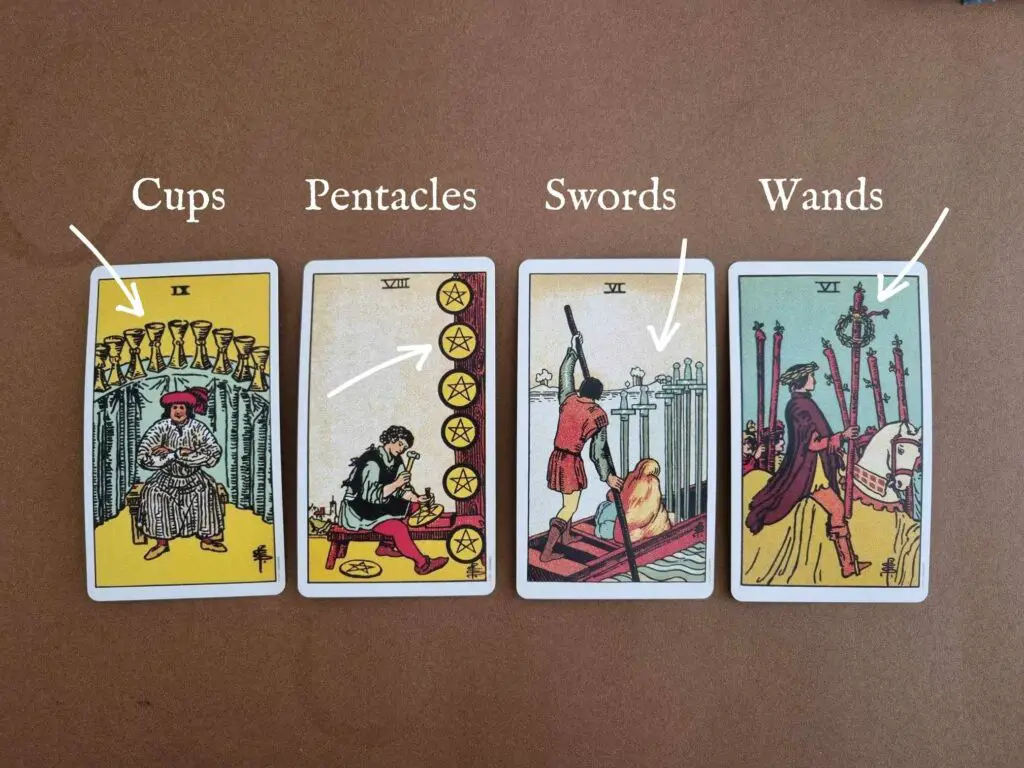
Each suit consists of 14 cards, with ten numbered cards and four court cards: Page, Knight, Queen, and King. The numbered cards represent different levels of the suit’s energy, while the court cards represent different personalities or archetypes.
To identify the Minor Arcana cards, look for the suit symbol and the number. They can also be court cards, and in this case, you will find a name at the bottom of the card.
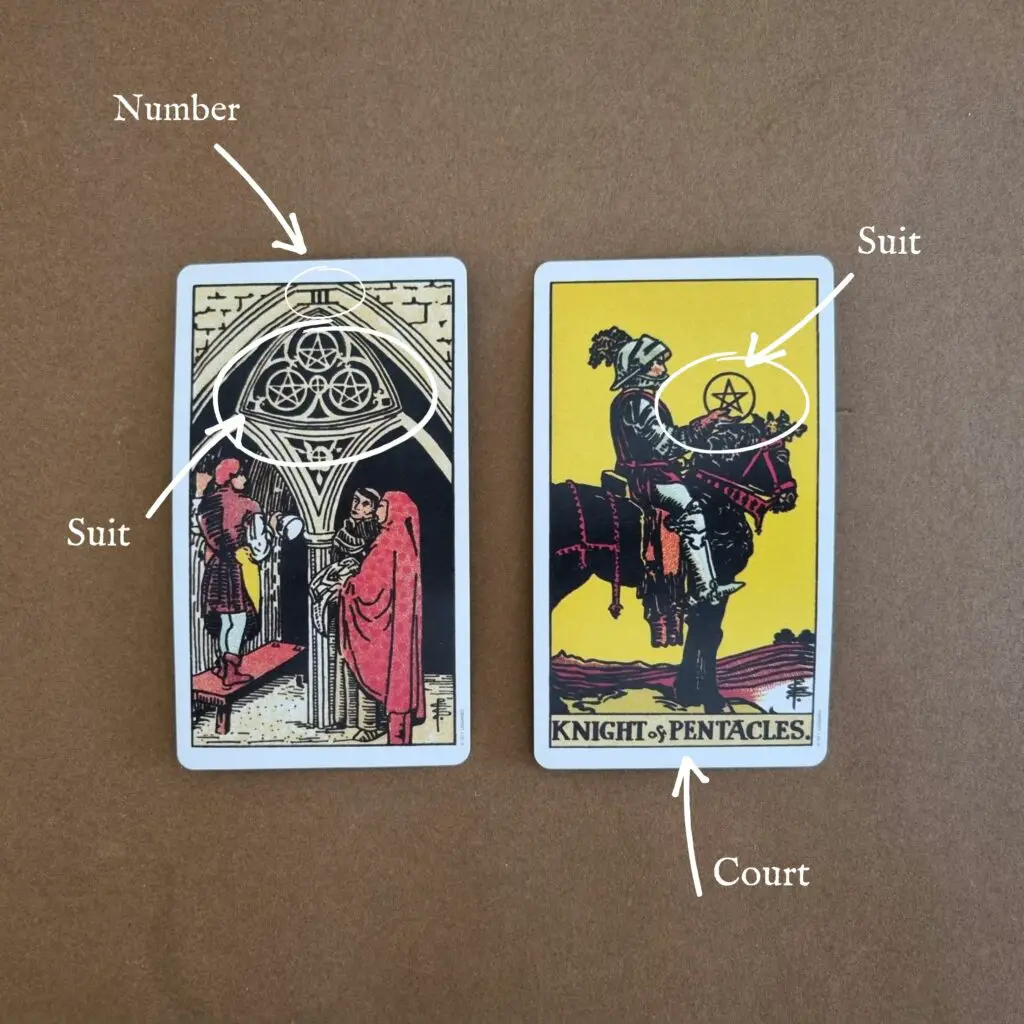
The imagery on the card will also provide clues to its meaning and interpretation.
For example, the Three of Pentacles shows the learning process. It indicates how knowledge passes through life. We learn from skilled persons, and professional persons learn from beginners as they see things with fresh eyes.
As you become more familiar with the tarot, you’ll recognize the patterns and symbolism in the Minor Arcana cards, making it easier to interpret their meanings.
Remember that tarot is a highly personal practice; everyone may interpret the cards differently.
Trust your intuition, and don’t be afraid to explore and experiment with different interpretations of the cards.
Related article: Reversed Tarot Cards: What They Are And How To Read Them
Minor Arcana card’s names and meanings
| Suit | Card Number | General Meaning | Keywords |
|---|---|---|---|
| Wands | Ace | New Beginnings | Inspiration, creativity, opportunity, new ideas |
| Wands | 2 | Partnership | Collaboration, teamwork, balance, harmony |
| Wands | 3 | Progress | Growth, expansion, forward movement, innovation |
| Wands | 4 | Celebration | Joy, accomplishment, excitement, socializing |
| Wands | 5 | Challenge | Conflict, competition, struggle, obstacles |
| Wands | 6 | Success | Victory, achievement, recognition, overcoming obstacles |
| Wands | 7 | Vision | Planning, strategy, foresight, future-oriented thinking |
| Wands | 8 | Speed | Action, quick decisions, movement, progress |
| Wands | 9 | Strength | Determination, courage, resilience, confidence |
| Wands | 10 | Completion | Fulfillment, accomplishment, culmination, wholeness |
| Wands | Page | Exploration | New beginnings, enthusiasm, learning, curiosity |
| Wands | Knight | Action | Energy, enthusiasm, impulsiveness, adventure |
| Wands | Queen | Creativity | Confidence, independence, creativity, leadership |
| Wands | King | Leadership | Authority, ambition, determination, success |
| Suit | Card Number | General Meaning | Keywords |
|---|---|---|---|
| Cups | Ace | New Beginnings | Emotional connection, new relationships, creativity |
| Cups | 2 | Partnership | Harmony, balance, unity, cooperation |
| Cups | 3 | Celebration | Abundance, happiness, friendship, joy |
| Cups | 4 | Stability | Security, structure, foundation, groundedness |
| Cups | 5 | Loss | Disappointment, heartbreak, grief, emotional pain |
| Cups | 6 | Harmony | Peace, reconciliation, balance, healing |
| Cups | 7 | Illusion | Fantasy, dreams, deception, disillusionment |
| Cups | 8 | Reflection | Self-reflection, introspection, inner awareness, contemplation |
| Cups | 9 | Satisfaction | Contentment, fulfillment, gratitude, happiness |
| Cups | 10 | Joy | Emotional fulfillment, happiness, spiritual growth, enlightenment |
| Cups | Page | Intuition | Emotional intelligence, sensitivity, creativity, inspiration |
| Cups | Knight | Romance | Emotional intensity, passion, idealism, charm |
| Cups | Queen | Compassion | Empathy, nurturing, emotional intelligence, healing |
| Cups | King | Emotional Balance | Emotional maturity, understanding, stability, generosity |
| Suit | Card Number | General Meaning | Keywords |
|---|---|---|---|
| Swords | Ace | New Beginnings | Mental clarity, new ideas, new perspective, communication |
| Swords | 2 | Partnership | Cooperation, communication, negotiation, diplomacy |
| Swords | 3 | Heartache | Loss, sorrow, emotional pain, grief |
| Swords | 4 | Rest | Recovery, rest, rejuvenation, healing |
| Swords | 5 | Conflict | Challenge, adversity, tension, hostility |
| Swords | 6 | Transition | Change, adaptation, transformation, progress |
| Swords | 7 | Betrayal | Deceit, dishonesty, betrayal, manipulation |
| Swords | 8 | Justice | Fairness, balance, truth, consequences |
| Swords | 9 | Anxiety | Fear, worry, uncertainty, insecurity |
| Swords | 10 | Defeat | Failure, defeat, loss, surrender |
| Swords | Page | Curiosity | Intellectual |
the Arcanas in tarot readings
The Minor and Major arcana tarot cards are used together in reading to provide insight and guidance on a particular situation or question.
How to use the Arcanas in tarot readings
- Shuffle the cards: Before you start a reading, shuffle the cards thoroughly to ensure that they are randomized and that you are not biased toward any particular card or outcome.
- Ask your question: Formulate your question or intention clearly in your mind, and hold it in your thoughts as you draw the cards.
- Draw the cards: Draw a predetermined number from the deck. The number of cards you draw will depend on your spread (e.g., a three-card spread, a Celtic Cross spread, etc.).
- Interpret the cards: Interpret the meaning of each card individually, and then consider the overall message or theme that emerges from the cards you have drawn. The Major Arcana cards typically represent significant life events or themes, while the Minor Arcana cards represent day-to-day experiences and challenges.
- Consider the context: Consider the context of the cards in relation to the question or situation you are asking about. What insights or guidance do the cards offer in this context?
- Trust your intuition: Remember that tarot readings are not set in stone and that your intuition and personal interpretation of the cards are essential factors in the reading process. Trust your insights and intuition, and allow the cards to guide you towards greater ones understanding and awareness.
Combining the insights and symbolism of the Major and Minor arcana cards in a tarot reading can give you valuable insights into your life and your situations. It brings nuance and detailed information that can be very helpful in making empowered decisions.
With practice and experience, you can learn to read the cards intuitively and use them as a tool for personal growth and self-awareness.
Do you want a cheat sheet for all the tarot card meanings? You find them here.
